Bristol M1C (Gypsy Powered) Racer |
Back to top
|
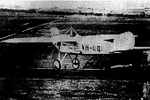 The
M1C was
designed by Bristol Aircraft in the UK as a WWI fighter, and two were
imported to Australia by Harry Butler. One was modified for racing by
Horrie Miller, with a Gypsy inline engine, and a slimmer
fuselage. The
M1C was
designed by Bristol Aircraft in the UK as a WWI fighter, and two were
imported to Australia by Harry Butler. One was modified for racing by
Horrie Miller, with a Gypsy inline engine, and a slimmer
fuselage. |
 The
plan is
for a simplified model to
the "neo Dime Scale" rules of the Flying
Aces Club (FAC). Several models have been constructed from this plan,
including Kevin Mooney's version, shown in the picture. The
plan is
for a simplified model to
the "neo Dime Scale" rules of the Flying
Aces Club (FAC). Several models have been constructed from this plan,
including Kevin Mooney's version, shown in the picture. |
|
Plan
for 406mm (16") model:
PDF
for A4 paper (78 KB)
PDF for Letter paper
(61 KB)
|
CAC CA-2 Wackett Trainer (prototype version with Gypsy in-line engine) |
Back to top
|
 As
World War II
loomed on the horizon, Australia needed a training aircraft to train
the new generation of pilots who would soon be needed. So the Wackett
was developed to meet this need. The two prototypes featured
in-line Gypsy engines, but these turned out to be underpowered. But
they still make a good subject for free flight scale model. As
World War II
loomed on the horizon, Australia needed a training aircraft to train
the new generation of pilots who would soon be needed. So the Wackett
was developed to meet this need. The two prototypes featured
in-line Gypsy engines, but these turned out to be underpowered. But
they still make a good subject for free flight scale model. |
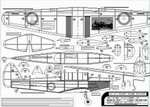 The
plans are drawn for a 406mm (16") span "Pseudo
Dime Scale" model of the Wackett prototype for rubber power. Plan
prints on 2 pages. The
plans are drawn for a 406mm (16") span "Pseudo
Dime Scale" model of the Wackett prototype for rubber power. Plan
prints on 2 pages. |
|
Plan
for 406mm (16") model:
PDF for A4 paper
(81 KB)
PDF for Letter paper
(81 KB)
|
CAC CA-6 Wackett Trainer (production version with Warner Scarab radial
engine) |
Back to top
|
 The
solution to the
under-powered state of the CA-2 prototypes was to install a Warner
Scarab radial engine. In this new
form, the Wackett met the
requirements of the RAAF trainer specification, and 200 Wacketts were
constructed and saw service with the RAAF and the Dutch East Indies
Air Force (now Indonesia). The
solution to the
under-powered state of the CA-2 prototypes was to install a Warner
Scarab radial engine. In this new
form, the Wackett met the
requirements of the RAAF trainer specification, and 200 Wacketts were
constructed and saw service with the RAAF and the Dutch East Indies
Air Force (now Indonesia). |
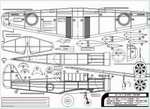 The
plans are drawn for a 406mm (16") span "Pseudo
Dime Scale" model of the Wackett for rubber power. The plan prints on 2
pages. The
plans are drawn for a 406mm (16") span "Pseudo
Dime Scale" model of the Wackett for rubber power. The plan prints on 2
pages. |
|
Plan
for 406mm (16") model:
PDF for A4 paper
(81 KB)
PDF for Letter paper
(81 KB)
|
CAC CA-15 |
Back to top
|
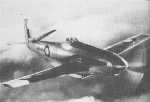 The
CA-15 was a
prototype fighter developed in the closing stages of WWII. It
represented the peak in piston-powered performance. The
CA-15 was a
prototype fighter developed in the closing stages of WWII. It
represented the peak in piston-powered performance. |
I've
presented plans at two different sizes (see at right), showing all
formers, ribs and other templates.
|
|
Plans
for 24" model:
PDF
for A4 paper (146 KB) 12 pages
PDF for Letter paper (152 KB) 12 pages
Plans for 18" (1/2" or 1:24 scale) model:
PDF
for A4 paper (108 KB)
PDF for Letter paper
(105 KB)
|
CAC CA-23 Ceres |
Back to top
|
 The
Ceres was
developed by CAC in the 1950's as an agricultural aircraft for
top-dressing. It was a new design, but utilised some components from
surplus Wirraway trainers. It was a larger,
heavier and
more
powerful aircraft compared to the Wirraway. The pilot was seated in a
raised cockpit (in a similar location to the rear seat of the Wirraway)
aft of the hopper for an improved view. The landing gear was fixed.
Large slotted flaps were fitted as were fixed leading edge slats on the
outboard wing panels. The
Ceres was
developed by CAC in the 1950's as an agricultural aircraft for
top-dressing. It was a new design, but utilised some components from
surplus Wirraway trainers. It was a larger,
heavier and
more
powerful aircraft compared to the Wirraway. The pilot was seated in a
raised cockpit (in a similar location to the rear seat of the Wirraway)
aft of the hopper for an improved view. The landing gear was fixed.
Large slotted flaps were fitted as were fixed leading edge slats on the
outboard wing panels. |
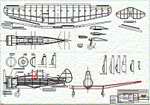 The plans are
drawn for a 610mm (24") span scale model of the Ceres for rubber power
(prints out on 6 sheets of paper). The plans are
drawn for a 610mm (24") span scale model of the Ceres for rubber power
(prints out on 6 sheets of paper). |
|
Plan
for 610mm (24") model:
PDF for A4 paper
(55 KB)
PDF for Letter paper
(55 KB)
|
CAC CA-25 Winjeel |
Back to top
|
 The
Winjeel was
developed in the late 40s and early 50s as an ab-initio trainer to
replace the Tiger Moth in RAAF service. It continued in service into
the 1980's as a forward air control aircraft. The
Winjeel was
developed in the late 40s and early 50s as an ab-initio trainer to
replace the Tiger Moth in RAAF service. It continued in service into
the 1980's as a forward air control aircraft.
|
Plan
for 660mm (26") model:
PDF for A4 paper
(81 KB)
PDF for Letter paper
(81 KB)
|
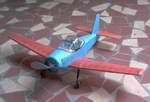 The plans are drawn for a 660mm (26") span scale model of
the Winjeel for rubber power or a geared KP-01 electric. Wing area is
97 sq ins. The plan prints out on 9 sheets of A4 or Letter
paper. The model shown at left was built by Sidney Elliott from these
plans. The plans are drawn for a 660mm (26") span scale model of
the Winjeel for rubber power or a geared KP-01 electric. Wing area is
97 sq ins. The plan prints out on 9 sheets of A4 or Letter
paper. The model shown at left was built by Sidney Elliott from these
plans.
|
Duigan 1913 Tractor Biplane |
Back to top
|
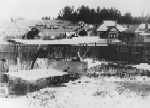 After
venturing to England and working with Avro, John Duigan returned to
Australia and built a second tractor biplane in his backyard in
suburban Melbourne in 1913. After
venturing to England and working with Avro, John Duigan returned to
Australia and built a second tractor biplane in his backyard in
suburban Melbourne in 1913. |
| Here's
the plan for a 635mm (25") span free flight model of Duigan's
1913 biplane powered by a KP-01 geared electric motor. |
|
Plan
for 25" model:
PDF for A4 paper (34 KB)
|
Gippsland Aeronautics GA-8 Airvan |
Back to top
|
 The
GA-8 is an 8 passenger utility plane being developed in Australia. It
recently received type certification in the USA (becoming the 7th
Australian aircraft to achieve this). The
GA-8 is an 8 passenger utility plane being developed in Australia. It
recently received type certification in the USA (becoming the 7th
Australian aircraft to achieve this). |
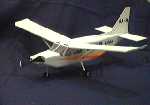 The
plan
is for a
560mm (22") span rubber powered model of the Airvan. Prints out on 4
pages. The model shown here is a 150% scaled version (33" span) built
by Wilton Adriano. The
plan
is for a
560mm (22") span rubber powered model of the Airvan. Prints out on 4
pages. The model shown here is a 150% scaled version (33" span) built
by Wilton Adriano. |
|
Plans
for 560mm (22") model:
PDF for A4 paper
(70 KB)
PDF for Letter Paper
(70 KB)
3-view drawings:
PDF for A4 paper
|
GAF N22 Nomad |
Back to top
|
 The Nomad is
a twin engined STOL utility aircraft developed in Australia in the
1970's. The Nomad is
a twin engined STOL utility aircraft developed in Australia in the
1970's. |
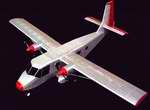 This
plan is for a 710mm (28") span rubber powered model of the Nomad
N22. The plan prints out on 10 pages, showing all formers, ribs and
other templates. This
plan is for a 710mm (28") span rubber powered model of the Nomad
N22. The plan prints out on 10 pages, showing all formers, ribs and
other templates. |
|
Plans
for 28" model:
PDF
for A4 paper (115 KB)
PDF for Letter paper
(114 KB)
|
Howard Hughes Engineering Lightwing |
Back to top
|
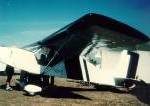 The Lightwing is an ultralight
designed and manufactured in Australia
to meet ANO 95.2. I first saw the Lightwing at the SAAA Mangalore
airshow in 1986. Its simple lines and large wing make it an ideal scale
model subject. The Lightwing is an ultralight
designed and manufactured in Australia
to meet ANO 95.2. I first saw the Lightwing at the SAAA Mangalore
airshow in 1986. Its simple lines and large wing make it an ideal scale
model subject. |
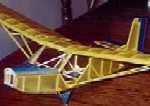 This plan is available in 2
sizes: 20" span for a KP-00 or 30" span for a KP-01. This plan is available in 2
sizes: 20" span for a KP-00 or 30" span for a KP-01. |
|
Plan
for 760mm (30") model:
PDF for A4 paper
(39 KB)
Plan for 510mm (20") model:
PDF
for A4 paper
(25 KB) |
Kingsford Smith Aviation Services KS-1 & KS-2 |
Back to top
|
 Australia has
always been one of the world's largest agricultural producers, and this
has fueled the demand for agricultural aircraft. The KS.1 was a post WWII conversion of the Wackett
trainer for top-dressing and spraying - by replacing the front cockpit
with a hopper. Australia has
always been one of the world's largest agricultural producers, and this
has fueled the demand for agricultural aircraft. The KS.1 was a post WWII conversion of the Wackett
trainer for top-dressing and spraying - by replacing the front cockpit
with a hopper. |
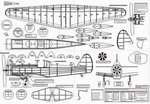 The plan is for a ½" scale
(1:24) rubber powered model of 470mm (18.5") span. The plan is for a ½" scale
(1:24) rubber powered model of 470mm (18.5") span. |
|
Plan
for 470mm (18.5") model:
PDF for A4 paper
(99 KB, prints out on 4 sheets)
PDF
for Letter paper (100 KB, prints out on 4 sheets)
3-view drawings:
PDF for A4 paper
|
Kingsford Smith Aviation Services KS-3 Cropmaster |
Back to top
|
 Following on from the
KS.1 and KS.2, the KS.3 was the first production version of Kingsford
Smith Aviation's Cropmaster. Following on from the
KS.1 and KS.2, the KS.3 was the first production version of Kingsford
Smith Aviation's Cropmaster.
The KS.3 featured the pilot in
the
original front seat position of the Wackett, and the rear seat was
replaced with the
hopper.
|
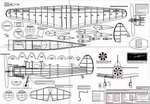 The plan is for a
Walnut Scale rubber
powered model of 457mm (18") span. The plan is for a
Walnut Scale rubber
powered model of 457mm (18") span. |
|
Plan
for 457mm (18") model:
PDF for A4 paper
(83 KB, prints out on 4 sheets)
3-view drawings:
PDF for A4 paper
|
Southern Cross Aviation SC1 |
Back to top
|
 The
SC1 was a prototype for a 4-place trainer or tourer. It first flew in
1962, but never went into production due to competition from imported
trainer aircraft. The
SC1 was a prototype for a 4-place trainer or tourer. It first flew in
1962, but never went into production due to competition from imported
trainer aircraft.
The sole prototype is now being restored at the Museum of Army Aviation
in Oakey, Queensland (on loan from the Australian National Aviation
Museum at Moorabbin airport in Melbourne).
|
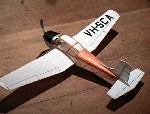 This
plan is for a 520mm (20.5") span rubber powered model. The plan prints
out on several pages. It includes templates for "do it yourself"
printwood. This
plan is for a 520mm (20.5") span rubber powered model. The plan prints
out on several pages. It includes templates for "do it yourself"
printwood. |
|
Plan
for 520mm (20.5") model:
PDF for A4 paper
(120 KB)
PDF for Letter paper
(120 KB)
|
Yeoman Aviation YA-1 Cropmaster 250 Prototype |
Back to top
|
 Developed
from the
Wackett trainer, the Cropmaster was a purpose-designed crop duster.
This plan is based on the first production YA-1 aircraft, featuring the
original wooden Wackett-style empennage. Developed
from the
Wackett trainer, the Cropmaster was a purpose-designed crop duster.
This plan is based on the first production YA-1 aircraft, featuring the
original wooden Wackett-style empennage. |
| This
plan is for a 610mm (24") span
rubber powered model. The plan prints out on 6 pages. All rib and
former templates are shown. |
|
Plan
for 610mm (24") span model:
PDF for A4 paper (120 KB)
PDF for Letter paper (120 KB) |
Yeoman Aviation Yeoman 175 Prototype |
Back to top
|
 In
order to test a
new all-metal empennage for the Cropmaster, Yeoman Aviation modified a
single Wackett airframe (VH-AIV) with the new tail unit and canopy
design. In
order to test a
new all-metal empennage for the Cropmaster, Yeoman Aviation modified a
single Wackett airframe (VH-AIV) with the new tail unit and canopy
design. |
| This
plan is for a 610mm (24") span
rubber powered model. The plan prints out on 6 pages. All rib and
former templates are shown. |
|
Plan
for 610mm (24") span model:
PDF for A4 paper (120 KB)
PDF for Letter paper (120 KB) |
Yeoman Aviation YA-1 Cropmaster 250R Series 2 |
Back to top
|
 The
Cropmaster
went through several developments during its service life, the final
version featuring an all-metal wing and all-metal empennage. The
Cropmaster
went through several developments during its service life, the final
version featuring an all-metal wing and all-metal empennage. |
| This
plan
is for a 610mm (24") span rubber powered model of the final
version. The plan prints out on 6 pages. All rib and former templates
are shown. |
|
Plan
for 610mm (24") span model:
PDF for A4 paper (120 KB)
PDF for Letter paper (120 KB) |
Here are some other plans
of aircraft with unique links to Australia:
|
|
Avro-Duigan 1911 |
|
 In
1911, John
Duigan went to England and ordered a plane from Avro to his own
specifications. The result was the Avro-Duigan. Avro subsequently
developed this aeroplane into the Avro 500 which was the immediate
predecessor of the famous Avro 504. In
1911, John
Duigan went to England and ordered a plane from Avro to his own
specifications. The result was the Avro-Duigan. Avro subsequently
developed this aeroplane into the Avro 500 which was the immediate
predecessor of the famous Avro 504. |
| The
plan presented here is for a
635mm (25") span free flight model powered by a KP-01 electric motor. |
|
Plan
for 25" span model:
PDF
for A4 paper (24KB file)
|
Taylorcraft Aeroplanes Auster Mk III |
|
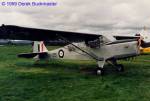 The Auster Mk III was
developed by Taylorcraft Aeroplanes (England)
during the Second World War as an observation platform for artillery
spotting. It was also adopted for communications roles. Many Mk III
aircraft made their way to Australia, and the Mk III was also
assembled Down Under. The Auster Mk III was
developed by Taylorcraft Aeroplanes (England)
during the Second World War as an observation platform for artillery
spotting. It was also adopted for communications roles. Many Mk III
aircraft made their way to Australia, and the Mk III was also
assembled Down Under. |
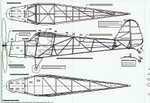 The
plans presented are for a 610mm
(24") span rubber powered model, with scale framework layout (the balsa
parts match up with the steel tube framework of the full size
aircraft). The
plans presented are for a 610mm
(24") span rubber powered model, with scale framework layout (the balsa
parts match up with the steel tube framework of the full size
aircraft). |
|
Plans
for 610mm (24") model:
PDF
for A4
paper (97 KB, prints on 10 sheets)
PDF for Letter Paper (97 KB, prints on 10 sheets) |
Bellanca YO-50 |
Back to top
|
 The Bellanca YO-50 was
developed in the early 1940's as an observation and liason aircraft for
the US army. 3 prototypes were built and tested, however the Army opted
for smaller, simpler liason aircraft (such as the Piper
L-3 and Stinson L-2). So the YO-50 never went into production. It was a
large aircraft, designed for high visibility (ie: it was easy to see out of the YO-50) and STOL
performance. (This aircraft has no links with Australia. I just liked
the look of it, and drew up the plan!) The Bellanca YO-50 was
developed in the early 1940's as an observation and liason aircraft for
the US army. 3 prototypes were built and tested, however the Army opted
for smaller, simpler liason aircraft (such as the Piper
L-3 and Stinson L-2). So the YO-50 never went into production. It was a
large aircraft, designed for high visibility (ie: it was easy to see out of the YO-50) and STOL
performance. (This aircraft has no links with Australia. I just liked
the look of it, and drew up the plan!)
|
Plan
for 610mm (24") model:
PDF for A4 paper (221KB file, prints out on 6
pages)
|

 The
Falcon is a
single-place aerobatic ultralight biplane. It was designed by
Eric Whitney (with the aim that it could be built by a home-builder in
a single-car garage) and the stress calculations were carried out by
Bill
Whitney. Two Falcons have been constructed to date, the first by
Bill Knight (shown in the photo).
The
Falcon is a
single-place aerobatic ultralight biplane. It was designed by
Eric Whitney (with the aim that it could be built by a home-builder in
a single-car garage) and the stress calculations were carried out by
Bill
Whitney. Two Falcons have been constructed to date, the first by
Bill Knight (shown in the photo).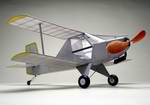 I have
presented plans in two
different sizes. One plan spans 22" (559mm) and has 129 square inches
of wing area. Suitable for rubber or KP-01 power. The plan prints on 6
pages.
I have
presented plans in two
different sizes. One plan spans 22" (559mm) and has 129 square inches
of wing area. Suitable for rubber or KP-01 power. The plan prints on 6
pages. The
Amsco monoplane is a rare Australian light plane developed by Percival "Perc" Pratt in Geelong in the 1930s.
The
Amsco monoplane is a rare Australian light plane developed by Percival "Perc" Pratt in Geelong in the 1930s.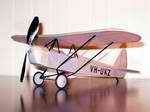 The plans are
drawn for a
330mm (13")
span Peanut scale model for rubber power. The plan prints out on 2
sheets of A4 paper. I've flown my own model built from this plan.
The plans are
drawn for a
330mm (13")
span Peanut scale model for rubber power. The plan prints out on 2
sheets of A4 paper. I've flown my own model built from this plan.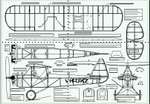
 The
M1C was
designed by Bristol Aircraft in the UK as a WWI fighter, and two were
imported to Australia by Harry Butler. One was modified for racing by
Horrie Miller, with a Gypsy inline engine, and a slimmer
fuselage.
The
M1C was
designed by Bristol Aircraft in the UK as a WWI fighter, and two were
imported to Australia by Harry Butler. One was modified for racing by
Horrie Miller, with a Gypsy inline engine, and a slimmer
fuselage. The
plan is
for a simplified model to
the "neo Dime Scale" rules of the Flying
Aces Club (FAC). Several models have been constructed from this plan,
including Kevin Mooney's version, shown in the picture.
The
plan is
for a simplified model to
the "neo Dime Scale" rules of the Flying
Aces Club (FAC). Several models have been constructed from this plan,
including Kevin Mooney's version, shown in the picture. As
World War II
loomed on the horizon, Australia needed a training aircraft to train
the new generation of pilots who would soon be needed. So the Wackett
was developed to meet this need. The two prototypes featured
in-line Gypsy engines, but these turned out to be underpowered. But
they still make a good subject for free flight scale model.
As
World War II
loomed on the horizon, Australia needed a training aircraft to train
the new generation of pilots who would soon be needed. So the Wackett
was developed to meet this need. The two prototypes featured
in-line Gypsy engines, but these turned out to be underpowered. But
they still make a good subject for free flight scale model. The
plans are drawn for a 406mm (16") span "Pseudo
Dime Scale" model of the Wackett prototype for rubber power. Plan
prints on 2 pages.
The
plans are drawn for a 406mm (16") span "Pseudo
Dime Scale" model of the Wackett prototype for rubber power. Plan
prints on 2 pages. The
solution to the
under-powered state of the CA-2 prototypes was to install a Warner
Scarab radial engine. In this new
form, the Wackett met the
requirements of the RAAF trainer specification, and 200 Wacketts were
constructed and saw service with the RAAF and the Dutch East Indies
Air Force (now Indonesia).
The
solution to the
under-powered state of the CA-2 prototypes was to install a Warner
Scarab radial engine. In this new
form, the Wackett met the
requirements of the RAAF trainer specification, and 200 Wacketts were
constructed and saw service with the RAAF and the Dutch East Indies
Air Force (now Indonesia). The
plans are drawn for a 406mm (16") span "Pseudo
Dime Scale" model of the Wackett for rubber power. The plan prints on 2
pages.
The
plans are drawn for a 406mm (16") span "Pseudo
Dime Scale" model of the Wackett for rubber power. The plan prints on 2
pages. The
CA-15 was a
prototype fighter developed in the closing stages of WWII. It
represented the peak in piston-powered performance.
The
CA-15 was a
prototype fighter developed in the closing stages of WWII. It
represented the peak in piston-powered performance. The
Ceres was
developed by CAC in the 1950's as an agricultural aircraft for
top-dressing. It was a new design, but utilised some components from
surplus Wirraway trainers. It was a larger,
heavier and
more
powerful aircraft compared to the Wirraway. The pilot was seated in a
raised cockpit (in a similar location to the rear seat of the Wirraway)
aft of the hopper for an improved view. The landing gear was fixed.
Large slotted flaps were fitted as were fixed leading edge slats on the
outboard wing panels.
The
Ceres was
developed by CAC in the 1950's as an agricultural aircraft for
top-dressing. It was a new design, but utilised some components from
surplus Wirraway trainers. It was a larger,
heavier and
more
powerful aircraft compared to the Wirraway. The pilot was seated in a
raised cockpit (in a similar location to the rear seat of the Wirraway)
aft of the hopper for an improved view. The landing gear was fixed.
Large slotted flaps were fitted as were fixed leading edge slats on the
outboard wing panels.  The plans are
drawn for a 610mm (24") span scale model of the Ceres for rubber power
(prints out on 6 sheets of paper).
The plans are
drawn for a 610mm (24") span scale model of the Ceres for rubber power
(prints out on 6 sheets of paper). The
Winjeel was
developed in the late 40s and early 50s as an ab-initio trainer to
replace the Tiger Moth in RAAF service. It continued in service into
the 1980's as a forward air control aircraft.
The
Winjeel was
developed in the late 40s and early 50s as an ab-initio trainer to
replace the Tiger Moth in RAAF service. It continued in service into
the 1980's as a forward air control aircraft. The plans are drawn for a 660mm (26") span scale model of
the Winjeel for rubber power or a geared KP-01 electric. Wing area is
97 sq ins. The plan prints out on 9 sheets of A4 or Letter
paper. The model shown at left was built by Sidney Elliott from these
plans.
The plans are drawn for a 660mm (26") span scale model of
the Winjeel for rubber power or a geared KP-01 electric. Wing area is
97 sq ins. The plan prints out on 9 sheets of A4 or Letter
paper. The model shown at left was built by Sidney Elliott from these
plans. After
venturing to England and working with Avro, John Duigan returned to
Australia and built a second tractor biplane in his backyard in
suburban Melbourne in 1913.
After
venturing to England and working with Avro, John Duigan returned to
Australia and built a second tractor biplane in his backyard in
suburban Melbourne in 1913. The
GA-8 is an 8 passenger utility plane being developed in Australia. It
recently received type certification in the USA (becoming the 7th
Australian aircraft to achieve this).
The
GA-8 is an 8 passenger utility plane being developed in Australia. It
recently received type certification in the USA (becoming the 7th
Australian aircraft to achieve this). The
plan
is for a
560mm (22") span rubber powered model of the Airvan. Prints out on 4
pages. The model shown here is a 150% scaled version (33" span) built
by Wilton Adriano.
The
plan
is for a
560mm (22") span rubber powered model of the Airvan. Prints out on 4
pages. The model shown here is a 150% scaled version (33" span) built
by Wilton Adriano. The Nomad is
a twin engined STOL utility aircraft developed in Australia in the
1970's.
The Nomad is
a twin engined STOL utility aircraft developed in Australia in the
1970's. This
plan is for a 710mm (28") span rubber powered model of the Nomad
N22. The plan prints out on 10 pages, showing all formers, ribs and
other templates.
This
plan is for a 710mm (28") span rubber powered model of the Nomad
N22. The plan prints out on 10 pages, showing all formers, ribs and
other templates.
 This plan is available in 2
sizes: 20" span for a KP-00 or 30" span for a KP-01.
This plan is available in 2
sizes: 20" span for a KP-00 or 30" span for a KP-01. Australia has
always been one of the world's largest agricultural producers, and this
has fueled the demand for agricultural aircraft. The KS.1 was a post WWII conversion of the Wackett
trainer for top-dressing and spraying - by replacing the front cockpit
with a hopper.
Australia has
always been one of the world's largest agricultural producers, and this
has fueled the demand for agricultural aircraft. The KS.1 was a post WWII conversion of the Wackett
trainer for top-dressing and spraying - by replacing the front cockpit
with a hopper. The plan is for a ½" scale
(1:24) rubber powered model of 470mm (18.5") span.
The plan is for a ½" scale
(1:24) rubber powered model of 470mm (18.5") span. Following on from the
KS.1 and KS.2, the KS.3 was the first production version of Kingsford
Smith Aviation's Cropmaster.
Following on from the
KS.1 and KS.2, the KS.3 was the first production version of Kingsford
Smith Aviation's Cropmaster.
 The plan is for a
Walnut Scale rubber
powered model of 457mm (18") span.
The plan is for a
Walnut Scale rubber
powered model of 457mm (18") span. The
SC1 was a prototype for a 4-place trainer or tourer. It first flew in
1962, but never went into production due to competition from imported
trainer aircraft.
The
SC1 was a prototype for a 4-place trainer or tourer. It first flew in
1962, but never went into production due to competition from imported
trainer aircraft. This
plan is for a 520mm (20.5") span rubber powered model. The plan prints
out on several pages. It includes templates for "do it yourself"
printwood.
This
plan is for a 520mm (20.5") span rubber powered model. The plan prints
out on several pages. It includes templates for "do it yourself"
printwood. Developed
from the
Wackett trainer, the Cropmaster was a purpose-designed crop duster.
This plan is based on the first production YA-1 aircraft, featuring the
original wooden Wackett-style empennage.
Developed
from the
Wackett trainer, the Cropmaster was a purpose-designed crop duster.
This plan is based on the first production YA-1 aircraft, featuring the
original wooden Wackett-style empennage. In
order to test a
new all-metal empennage for the Cropmaster, Yeoman Aviation modified a
single Wackett airframe (VH-AIV) with the new tail unit and canopy
design.
In
order to test a
new all-metal empennage for the Cropmaster, Yeoman Aviation modified a
single Wackett airframe (VH-AIV) with the new tail unit and canopy
design. The
Cropmaster
went through several developments during its service life, the final
version featuring an all-metal wing and all-metal empennage.
The
Cropmaster
went through several developments during its service life, the final
version featuring an all-metal wing and all-metal empennage.  In
1911, John
Duigan went to England and ordered a plane from Avro to his own
specifications. The result was the Avro-Duigan. Avro subsequently
developed this aeroplane into the Avro 500 which was the immediate
predecessor of the famous Avro 504.
In
1911, John
Duigan went to England and ordered a plane from Avro to his own
specifications. The result was the Avro-Duigan. Avro subsequently
developed this aeroplane into the Avro 500 which was the immediate
predecessor of the famous Avro 504. The Auster Mk III was
developed by Taylorcraft Aeroplanes (England)
during the Second World War as an observation platform for artillery
spotting. It was also adopted for communications roles. Many Mk III
aircraft made their way to Australia, and the Mk III was also
assembled Down Under.
The Auster Mk III was
developed by Taylorcraft Aeroplanes (England)
during the Second World War as an observation platform for artillery
spotting. It was also adopted for communications roles. Many Mk III
aircraft made their way to Australia, and the Mk III was also
assembled Down Under. The
plans presented are for a 610mm
(24") span rubber powered model, with scale framework layout (the balsa
parts match up with the steel tube framework of the full size
aircraft).
The
plans presented are for a 610mm
(24") span rubber powered model, with scale framework layout (the balsa
parts match up with the steel tube framework of the full size
aircraft). The Bellanca YO-50 was
developed in the early 1940's as an observation and liason aircraft for
the US army. 3 prototypes were built and tested, however the Army opted
for smaller, simpler liason aircraft (such as the Piper
L-3 and Stinson L-2). So the YO-50 never went into production. It was a
large aircraft, designed for high visibility (ie: it was easy to see
The Bellanca YO-50 was
developed in the early 1940's as an observation and liason aircraft for
the US army. 3 prototypes were built and tested, however the Army opted
for smaller, simpler liason aircraft (such as the Piper
L-3 and Stinson L-2). So the YO-50 never went into production. It was a
large aircraft, designed for high visibility (ie: it was easy to see